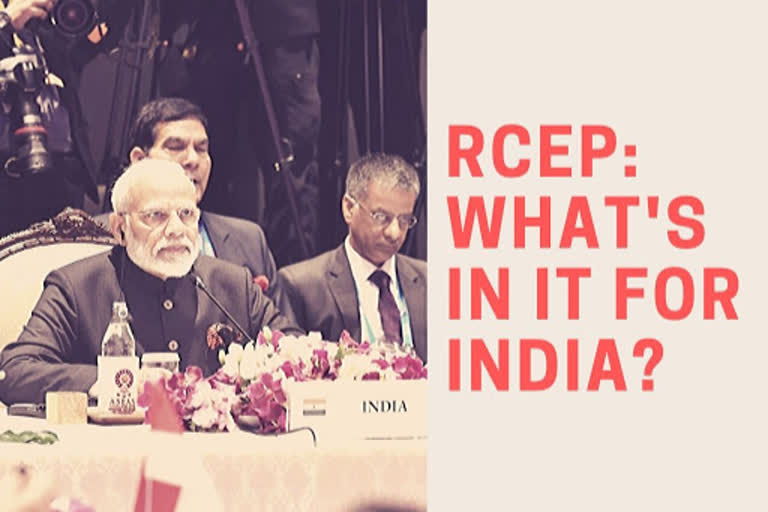Hyderabad: Prime Minister Narendra Modi is in Thailand to attend the third Summit Regional Comprehensive Economic Partnership (RCEP) scheduled to be held on Monday. In view of the ongoing negotiations for the RCEP deal there, here is a look at some of the potentially positive and negative aspects of the trade pact for India.
First, the negatives:
India’s trade balance with the trading partner usually worsens after a Free Trade Agreement (FTA) becomes operational.
Economic Survey, 2017-18 had studied the impact of free trade agreements (FTAs) signed by India. That an appraisal of India’s existing FTAs by the NITI Aayog is instructive. The survey concluded that the average effect of an FTA is to increase overall trade by about 50 percent over roughly four years. But the quality of trade balance usually worsens for India. In other words, the trade deficit increases, or the surplus reduces.
ASEAN is one of India’s largest trading partners. The CECA with ASEAN kicked off from January 1, 2010. After which, bilateral trade surged from $43 billion in 2009-10 to $97 billion in 2018-19. But India’s trade deficit with ASEAN has more than doubled from less than $ 8 billion in 2009-10 to $ 22 billion in 2018-19. This is because imports from ASEAN are increasing at a faster pace than Indian exports to ASEAN. In the case of the India - ASEAN FTA, the trade balance has worsened for 13 out of 21 sectors. The sectors that lost out include textiles, chemicals, vegetable products, base metals, gems, and jewelry. The improvement in the trade surplus sectors was so marginal it could not offset the losses.
The impact of most of the other preferential trade agreements on India’s trade balance is no different. The India-Korea CEPA also became effective operational from January 1, 2010. Bilateral trade since then between the two countries has grown from $ 12 billion to $ 21.5 billion. But again, imports grew a lot faster than exports. As a result, India’s trade deficit with Korea has nearly trebled, increasing from $5 billion in 2009-10 to $ 12 billion 2018-19.
The India-Japan CEPA became operational from August 1, 2011. After which India’s trade deficit has in fact grown at a rate even faster than India’s trade deficit with the rest of the world has.
The only exception where a preferential trade agreement has improved the quality of trade for India vis-a-via the trading partner is SAFTA (South Asian Free Trade Area) that became operational from January 1, 2006. From 2005-06 to 2018-19, India’s trade surplus with the SAFTA economies grew manifold from $4 billion to $21 billion.
Underutilisation of the existing FTAs
India’s trade balance tends to worsen with its FTA partners because Indian exporters fail to take advantage of the preferential routes as much as the trading partners’ exporters do. In fact, the percentage of India’s international trade routed through FTAs is very low. According to the Asian Development Bank, the utilisation rate of FTAs is less than 25 percent, which is among the lowest in Asia.
The primary reason for this underutilisation of the existing FTAs is that the Indian export sector is fragmented with low capacity to incur the compliance costs needed to figure out the complex rules of origin criteria. Exporters prefer using the normal route. Besides stricter rules of origin, faulty commitments and lack of awareness are also significant limiting factors.
An examination of the India-Japan Comprehensive Economic Partnership Agreement (CEPA) that kicked off on 1 August 2011 by researchers Arpita Mukherjee, Angana Parashar Sarma and Soham Sinha of the Indian Council for Research on International Economic Relations (ICRIER) and Anusree Paul of the Indian School of Business and Finance is insightful. Japan that is a major global importer of apparels shows how Indian exporters are simply unable to corner bigger market shares even when there are zero tariffs. Under the India-Japan CEPA, both countries dropped tariffs on apparels to zero. Yet Japan is still not among India’s top apparel export markets. Apparel exports to Japan have remained constant first after a brief initial blip. Although the relatively large and positive trade balance with Japan in apparels remains, India’s share in the Japanese market is barely 0.09 percent. Among India’s competitors, China has the largest share of 6.46 percent, followed by Vietnam (1.17 percent) and Bangladesh (0.34 percent).
Domestic constraints
Indian exporters face high transaction costs making them less competitive in the global market. Their price responsiveness is constrained by binding supply-side bottlenecks like energy shortages and higher logistics costs. According to the analysis by the NITI Aayog, logistics costs in India tend to be around twice that in developed countries. Average logistics costs in India are about 15 percent of GDP while such costs in developed countries are about 8 percent.
